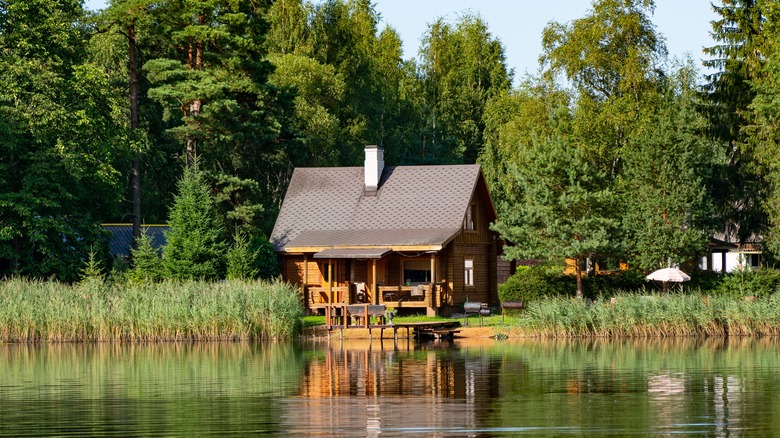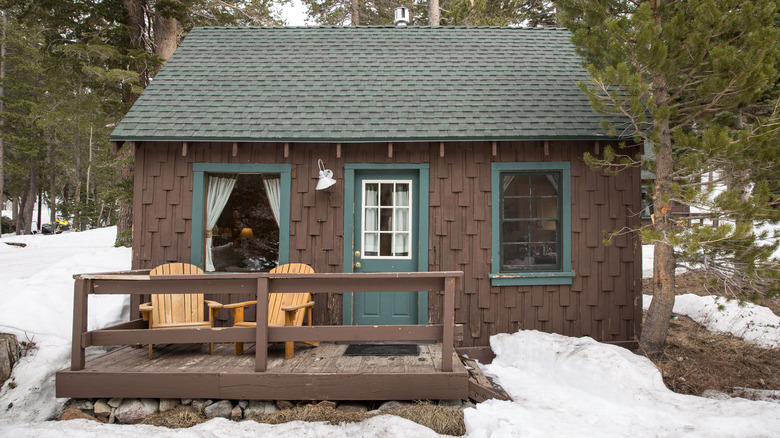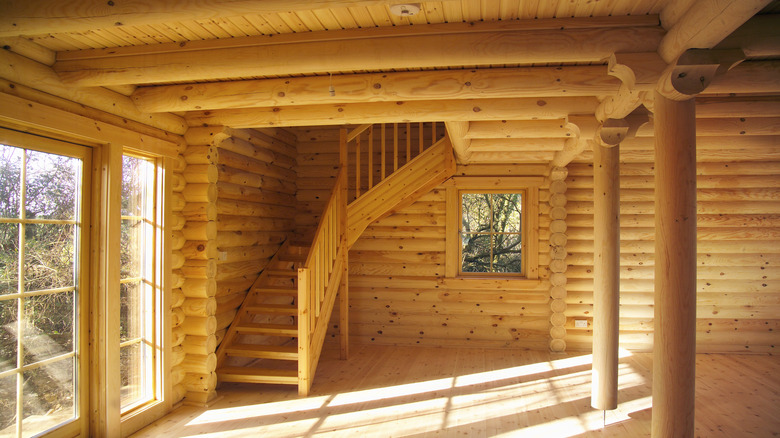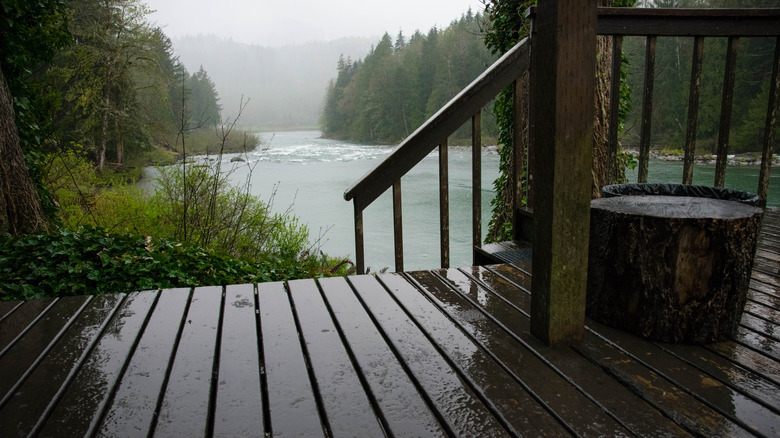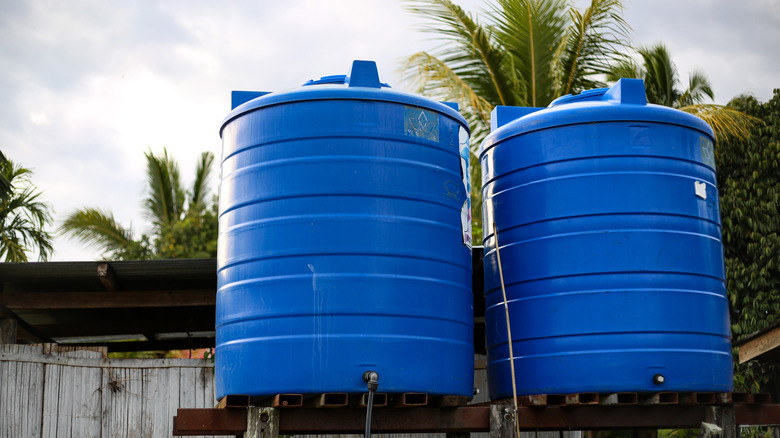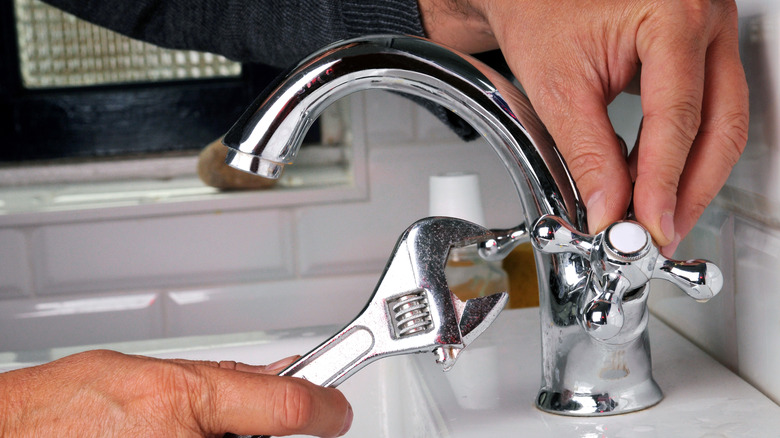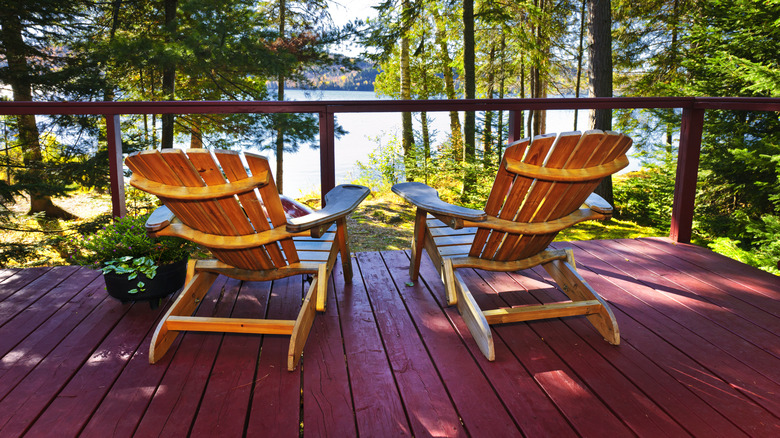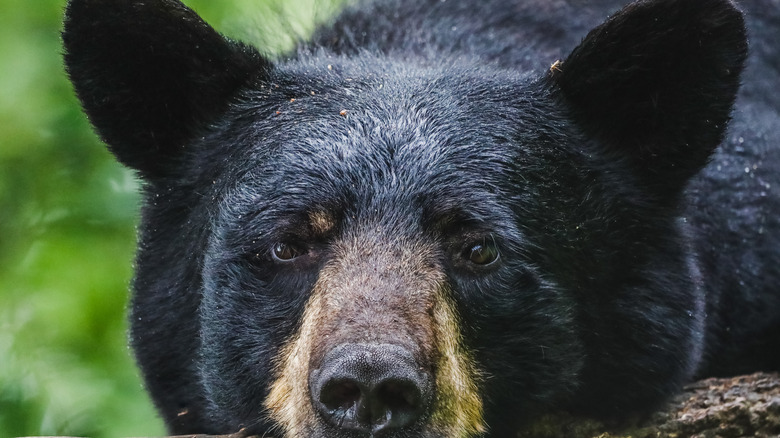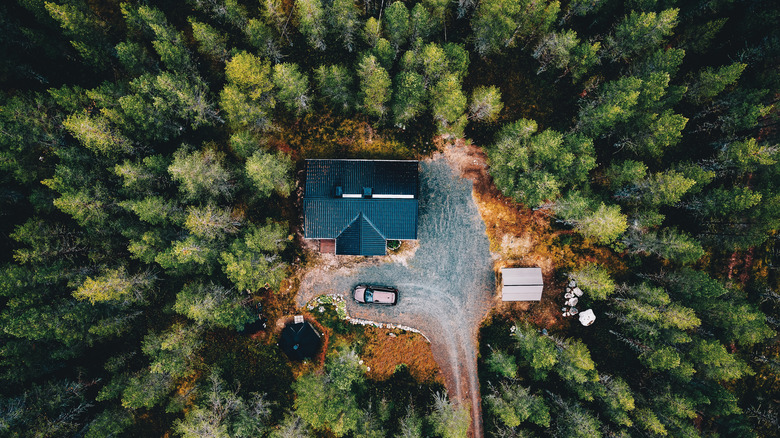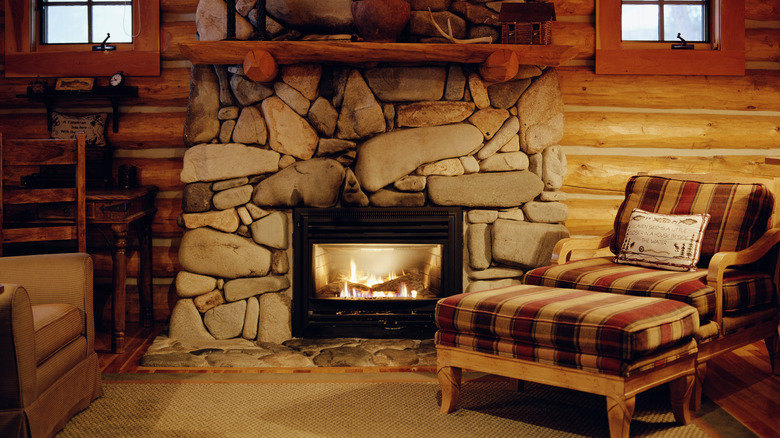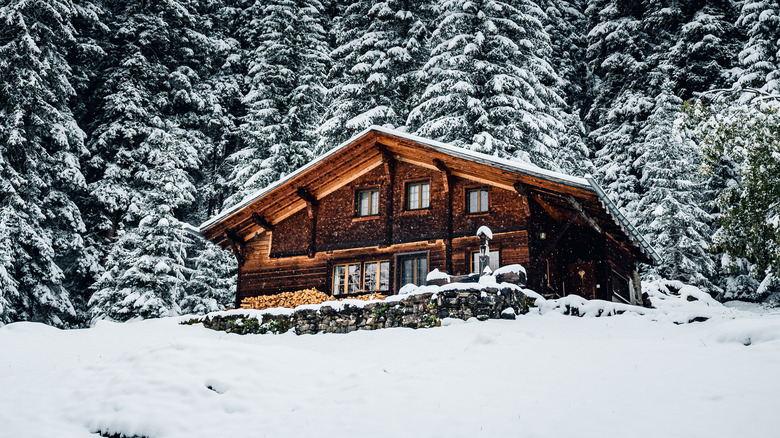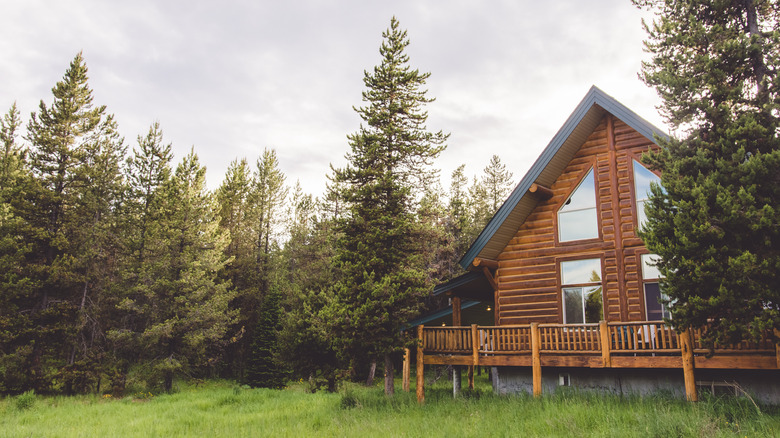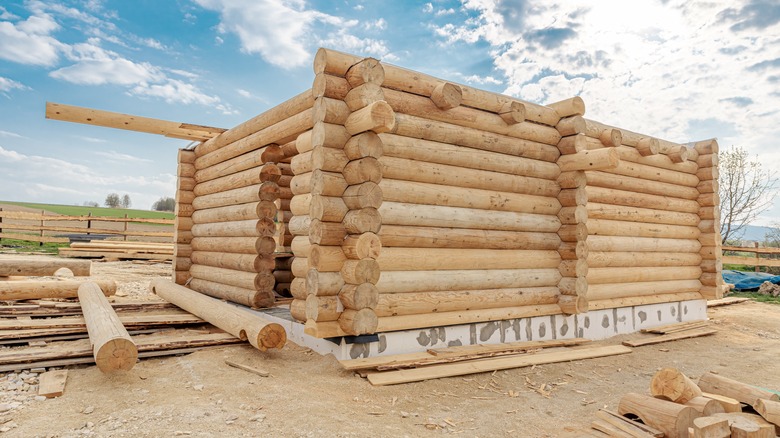Important Things You Need To Know About Living In A Log Cabin
If you are interested in living in a log cabin, there are some important things you need to know before the big move. The first is that living in a log cabin isn't the same as living in a log home. A log home is a mountain abode that's been built to mimic the traditional style of log cabins on its exterior, but it's very much modern through and through. However, log cabins tend to be a bit smaller, more rustic, and more remote. They also use fewer materials in their construction, just like in the olden days. Those living in log cabins for years often compare it to living "off the grid," making it drastically different from city living. Many log cabin owners live very drastically, with some even forgoing an indoor toilet in favor of an outhouse.
Of course, not all log cabins are tiny abodes that don't have electricity, but many are. If you plan to move to the mountains and live your best cottage core life, you might have to become used to the idea of giving up some of your everyday creature comforts. While it's possible to have a log cabin with all the "fixins," so to speak, they typically cost more either upfront or through extensive renovations after purchase. Before you make the leap, be sure to think through each consideration to decide your best course of action.
You will need to downsize before moving
Even if you already live in a smaller home, you will likely need to downsize your belongings before you move to a cabin. Most cabins are on the smaller side and don't have lots of storage. While it certainly can be helpful to use something like the KonMari method to reduce personal items like clothing, documents, and mementos, most of your decluttering should focus on larger and less-used items, like furniture and seasonal things.
Depending on the size of the cabin you choose to live in, you might only need one set of bedroom furniture instead of the three you currently own for guests. In addition, your kitchen might be significantly smaller and with less storage. You will not only need to part with less-used gadgets like the bread maker, but also the fine china you only use around the holidays. The same could be said for other seasonal items, such as holiday decorations and clothing. While it is possible to build a storage shed for overflow items, you might find that you quickly become overwhelmed living with so much clutter.
There are different floor plans to choose from
Whether you are building or buying, not all cabins will look the same. Most folks might hold the idea of a log cabin in their mind as a rustic one-room home. If you've ever seen an episode of "Little House on the Prairie," you'll know what we mean. Yet there will always be different floor plans and sizes to choose from. There are traditionally-built log cabins that have one small living space for sleeping, eating, and working with an outhouse down the hill. There are also traditionally-built log cabins that are larger, with two bedrooms on either end of a larger living space, complete with a bathroom with modern plumbing.
If you are interested in a two-story cabin, this is possible. Builders have been creating elevated spaces in these homes for hundreds of years. In smaller homes, the second story is typically more of a loft than a full living space. Yet in larger cabins, you can see that the stairs are carefully crafted into the log planks in the wall for a safe, sturdy way to get upstairs. If you have a large family or enjoy hosting others, these larger cabins are likely a better fit for you.
Weather will become more important
Depending on how rustic your cabin is, the forecast will impact your day-to-day life more than you think. For example, if you live in a climate where it often rains, like the Pacific Northwest, or a region that gets a lot of snow, like Colorado, you will need to keep a closer eye on the health of your cabin. Wood tends to absorb lots of water, especially if it's not sealed correctly. Heavy rain or snowfall can cause damage like rotting and bowing over time if not attended to.
When you lived in the city, rain showers would not prompt a post-storm home examination, but cabins require this. In addition, the humid air of a storm tends to sneak in through the smallest crevices in log cabins. If you don't have climate control inside, mold and mildew may begin to grow on your home's interior, too. Those who live in log cabins must invest in things like sealants and caulks to prevent moisture from damaging the outside of their home, as well as fans to move around the air that does seep in.
Installing creature comforts is more complicated than you might think
Plumbing and electricity can be hard to install in a traditionally rustic log cabin. This isn't to say that your log cabin can't physically be fitted with a large-screen TV, dishwasher, and clothes dryer. It's getting them to work that's the issue. Even if you hire the world's most experienced contractor, the location of your home has the final say on how easy (re: budget-friendly) these things are going to be to get running.
Living in a log cabin comes with a lot of responsibility. If you live in a remote location, as most do, you won't have a power grid, public water, sewer, or even gas lines to connect to. If you're not interested in figuring out those logistics, try to buy an existing cabin connected to public resources instead. But if you're determined to live in the wilderness, there are some tips to keep in mind. Rather than hooking up to the grid, you can install solar panels and a generator to have electricity day and night. For plumbing, you can utilize a few off-grid water systems, such as well water and lake water. Both will require specialists to set up unless you have extensive experience.
Household maintenance will be your responsibility
If you choose to live in a log cabin in a more remote location, you should brush up on your handyman skills. There won't be a plumber on call if one of your pipes breaks, nor will there be an electrician should you start having some trouble with wiring. For small jobs, invest some time in educating yourself before you move. You should learn how to unclog a toilet and snake a drain. Make note of the most common reasons the toilet keeps running or the dishwasher might go out (if you have one).
If you choose to live in a more rustic cabin without internet or good cell service, you will need to stockpile a few written resources to help you. While you might typically throw away the manuals for your household electronics and appliances, keeping them to refer to in a pinch can really save you a headache. You can also purchase manuals on safely performing most household tasks from your favorite bookseller.
As always, no matter how remote your log cabin is, your safety always comes first. Only pursue DIY handiwork you know you can confidently and safely complete. Work with a licensed repair person if some major maintenance comes up, like a foundation repair. Just be ready to pay up for some extra travel costs.
You'll need to invest money in outdoor furniture
Most folks move to the woods to enjoy the outdoors, so investing in furniture to make this possible is a necessity. Typically, log cabins have large front porches. They are the perfect space for sitting down to enjoy your morning cup of coffee or to keep an eye on all the different critters that wander past. To make the space perfect, you will likely spend about $1,000+ on furniture and finishings, so keep that in mind when creating your budget.
To start, you will need to purchase a great place to sit. Whether you want two Adirondack chairs, two rocking chairs, or a large swing for multiple people is up to you. If your porch is large enough, you might even select all three options in different zones along its length. Most people will also want a table on the porch. You can use a larger table to gather around for meals, a smaller side table just to set things down on, or a low coffee table for drinks and games. When choosing fabrics for your porch (cushions, blankets, etc.), select textiles specially made for outdoor use so you get more life out of them.
You will have to contend with wildlife daily
When you live in more developed areas, you might not be used to dealing with wildlife too often. Sure, your backyard might have had a pesky squirrel that loved to make trouble or a couple of birds that visited each afternoon. Yet you did not have to think about wildlife movements and your safety while planning your day.
For example, if your log cabin is in a highly wooded area, you now have to think about encountering a carnivorous animal on your property. Homeowners should familiarize themselves with the signs that a mountain lion or bear is living nearby. Learn the shape and size of their paw prints, as well as their droppings. You should also know the local "feeding times" of the animals living near them, typically around dusk and dawn.
Living in such close proximity to wildlife requires a greater level of outdoor food safety. If you have a firepit or a stone oven on your property, ensure it is cleared of all food scraps after each use to avoid attracting animals. Do plan on enjoying the deer that might graze your front porch or the rabbits that run past, but remember that where this is prey, predators are often not far behind.
If building, selecting your site carefully is important
If you decide to build a log cabin instead of purchasing a pre-existing one, consider both safety and resale value when selecting your site. The first step is to partner with a real estate agent specializing in land sales. They will know more about what to look for than someone who typically just sells houses.
Next, consider the level of privacy you want for your home. You might not want your house to be seen from the road, and that's okay. Natural barriers like trees, ponds, creeks, and bushes can add a barrier between you and the outside world. Yet building too close to these barriers can also cause problems. Clearing trees can be an expensive and time-consuming part of the home-building process, and if you build too close to them, you might risk falling limb damage. Water barriers also pose a risk due to flooding.
While privacy is amazing, do also consider the overall resale value of your land as you look for a site to purchase. You may plan to live in this log cabin forever, but sometimes plans change. The number one thing buyers will look for in a cabin (other than privacy) is accessibility. How far is the nearest grocery store? How long does it take to get to the hospital in an emergency? Is the lot easily accessible from the main road by vehicle, or do you have to walk the last bit?
You might need to swap your furniture for something more rustic
When living in a log cabin, you might find that many furniture pieces and decorations from your previous home simply don't work anymore. For some, it was due to space constraints. The 12-foot sectional couch from their game room takes up nearly the entire living room in the cabin, so they had to swap it out for something smaller and more practical. Yet, for others, the aesthetic of their belongings didn't match their new home anymore.
For example, a mid-century modern lounge chair against the wooden wall of a log cabin just doesn't sit right for most. While some designers might be able to make this work, the two styles clash too much for most. In addition, delicate accents like glass tables or brass fixtures might look out of place against the sturdy features of the home. Instead, consider investing in heavier, wooden furniture that better fits the space. Try out items like sturdy wooden tables with larger chairs, aged wood cabinets, and vintage appliances for the kitchen.
Ensure you invest in a specialized contractor before building
Most folks who live in a log cabin purchase one on a nice plot of land. Yet, like in the pioneer days, building your home from the ground up is still a dream for many of us. If you decide to build your own log cabin instead of purchasing a pre-existing home, choose your contractor carefully. This is because the logs used in construction need to be handled a little bit differently than normal wood. They need to be milled correctly, as well as treated and sealed in a specific way to avoid damage.
If you hire a contractor that normally builds brick houses in the suburbs, you might find that the quality of your log cabin will suffer. The advice around hiring a contractor remains largely the same: Only choose workers with a license, insurance, recommendations, and an agreeable communication style. Yet the main standout when you plan to live in a log cabin is inspecting their portfolio. Ensure that the team you hire has a long history of sturdy, beautiful log cabins already under their belt. This way, you'll know your home will turn out the same.
Log cabins are great investments
Log cabins are great financial investments because their ROI for renting and selling tends to be higher than average. The main reason is due to scarcity in the market. Living the log cabin life is a highly desirable dream. Many think about leaving it all behind to move to the woods and enjoy nature. Yet there are not enough cabins to satisfy this demand, and they are certainly not all on the market at the same time. When purchasing your own log cabin, you will likely notice the market's competitiveness. If you ever decide to sell, well-maintained cabins on well-kept land tend to hold their value very well, regardless of the market's volatility.
This will work out markedly in your favor as someone living in a cabin. If you ever would like a secondary income stream, you can easily rent out your home for "vacation prices" on different vacation rental sites. This is an especially good idea if you only live in your cabin for part of the year. Instead of sitting empty, it can generate its own mortgage payments on the side, making you more than average rent.
Log cabins are environmentally friendly
If you want to reduce your overall carbon footprint, log cabin living is perfect for you. The environmental benefits of living in a log cabin start long before move-in day. It begins with using solid logs as the main construction material, as they are a renewable resource that doesn't require a lot of processing. Logs are typically locally sourced as well, which can cut down on both costs and carbon emissions. Using pre-cut timber (sometimes known as dead timber) is another more eco-friendly option to pursue.
Once the home is built, it's built to last. The thick walls can withstand the lashing of mother nature over the years. They need small bits of maintenance to endure weathering, but typically not big replacements, which cuts down on construction waste over the years. The width of the walls also means the cabin is highly insulated, so it requires less energy to heat and cool throughout the seasons. In some cases, the cabin might not have any temperature control at all, which significantly cuts down the power bill and the overall amount of emissions. Yet this doesn't mean the building is sweltering, simply that the walls tend to absorb heat throughout the day and release it at night, creating a more natural cycle.

